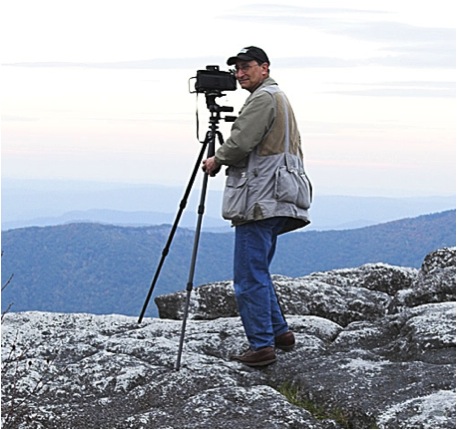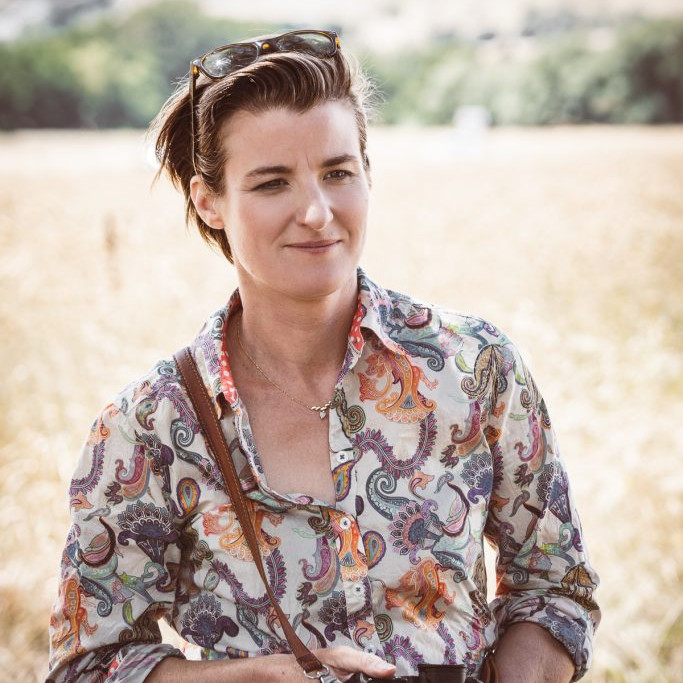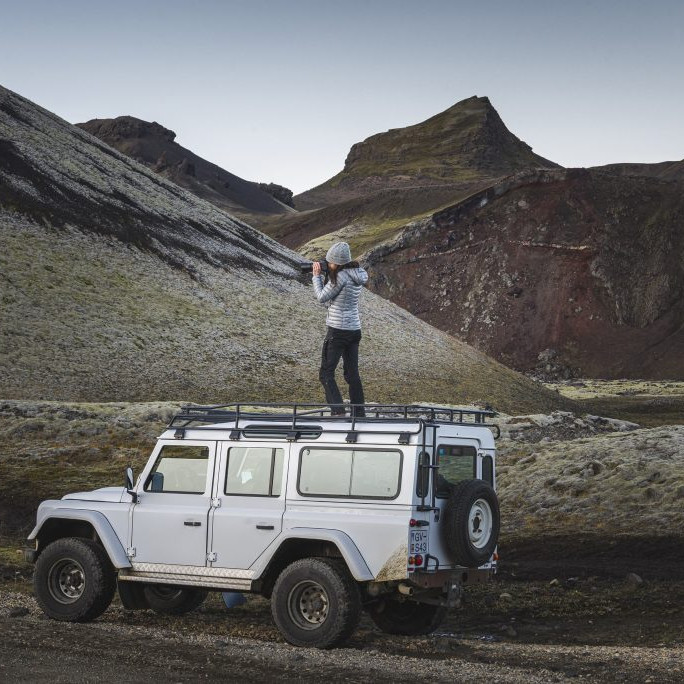Ben Greenberg Photographer - Virginia, USA
You thank the birth of your son for the start of your photographic life. Would you expand on this?
When my oldest son, Jeff, was born in 1970, I had had no experience at all with photography. Like any new father, I wanted to photograph my son. I didn’t even own a camera. So, my brother-in-law came through for me, lending me a Kodak Retina C. This was a basic camera without a single automatic feature. I had to learn photography from scratch and I had to do so quickly. I became fascinated with the process and it wasn’t long before I purchased an inexpensive used camera that allowed me more flexibility with its three lenses. I started photographing not only my son but the world around me, especially when I purchased a new 35mm Nikkormat in 1972. I was beginning my journey in photography.
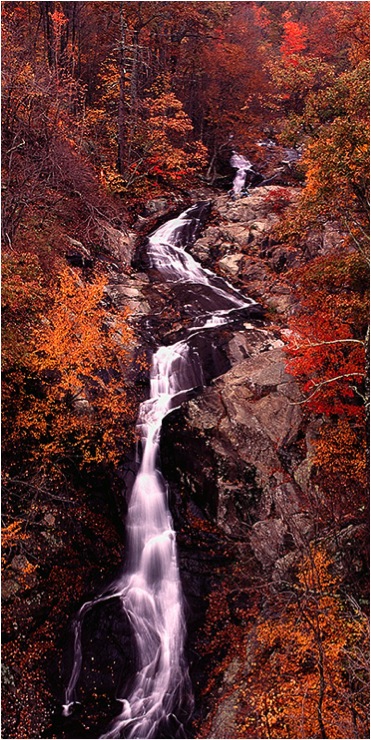
‘Whiteoak Canyon Falls No 1, Shenadoah National Park, Virginia’
In the past forty years as a photographer, there have been great technological changes. How has this impacted your photography?
You are absolutely correct about the great technological changes in the field of photography during the past forty years, but even my shift from 35mm photography to medium format photography with a Pentax 67 camera system pales in comparison to the shift from film to digital photography. I made that transition to digital photography in two stages. I was very cautious about this shift. I was getting such wonderful quality with my medium format slides that I didn’t want to take a step backwards.
In 2003 I purchased a computer and a printer that would allow me to work with scans of my slides. I quickly recognized the wonderful advantages of the digital darkroom over the traditional black and white and colour darkroom that I had for more than thirty years. This was particularly true for the preparation and printing of colour photographs, which I had done previously with the cibachrome process. For the next four years I scanned my slides with a rented and later purchased Minolta Dimage Multi-Pro scanner and I printed them on my Epson 2200, my first colour printer. I soon realized that with my medium format slides, I wanted to have the capability to print my images larger than the 2200 printer would allow.
I purchased the Epson 7800 printer that allowed me to make prints that were two feet by whatever length they needed to be. I was thrilled with the printer and wondering when I would be comfortable shifting to a digital camera system. Two events in the summer of 2007 conspired together to help me overcome the last hurdle; that of shooting digitally. I contracted with a real estate developing company to photograph their new community they were building. I realized that it would be faster and easier to do the shooting and meet their needs with a digital camera. It just so happened that Nikon had just brought out a new full frame digital camera, the D700. This 12.3 megapixel camera was less expensive than a number of other full frame cameras, I was unsure if it would give me the quality I demanded of my photographs. I decided I would need to conduct a test.
I shot the same outdoor scene with my Pentax 67 system and with the Nikon D700. I processed each set of images normally and prepared large prints from each. The results went far beyond what I expected. The prints from the D700 were sharper, had a wider tonal range than the photographs from the Pentax 67 and they had a perfect colour balance. I was immediately sold on the new Nikon and I immediately began my shift to becoming a digital photographer. I have since expanded my camera system with the Nikon D3x and its 24.5 megapixels and a set of lenses for my landscape photography.
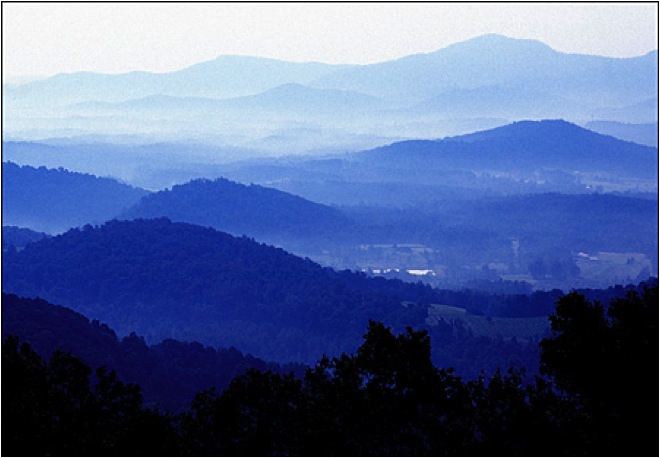
‘Blue Mountains’
Can you discuss how so many people do not realize the time it takes to get just the right shot?
I love finding new locations to photograph, locations that have great potential for the dramatic photographs of the natural environment I seek. Finding out about such places and researching them helps me prepare for the opportunities of photographing them. When I explore a location for the first time trying to take advantage of the early morning or late afternoon light, I feel very fortunate when all the elements of a dramatic landscape photograph come together at just the right time for me. It is even possible that I am able to find several possible images at the same location and of the same subject matter. Unfortunately, such opportunities don’t always present themselves. It is quite common that I recognize the potential for a wonderful image at a specific location but I must visit that location numerous times before the light, weather and subject matter come together in a way that inspires an image worthy of sharing with others. There are specific locations in my book, Natural Virginia,that I visited numerous times over eight to ten years before I captured the moment I had been seeking. There are other images in the book that were the result of several hours of waiting until the light was just right. There is little doubt that landscape photography has taught me the very important practice of patience.
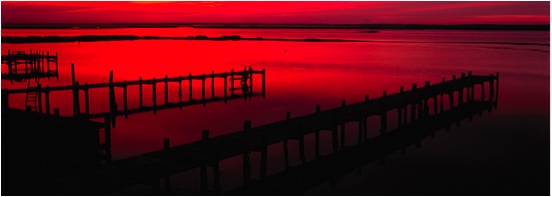
‘Chincoteague Bay Sunset’
While you are well-known for your landscape photography, can you discuss your architectural photographs?
Over the years I have recognized that while natural landscapes are my first attractions for photographing, I also enjoy finding unique images that feature architecture. This is primarily true of the University of Virginia, where I graduated from college and also attended graduate school. The University features unique architecture that is recognized around the world as the product of Thomas Jefferson, our third President and former resident of Albemarle County, which surrounds the city, Charlottesville, where I live. Just like natural landscapes, photographing architecture requires an interesting subject, strong lighting and positive weather conditions to be able to obtain a photograph of which one can be proud.
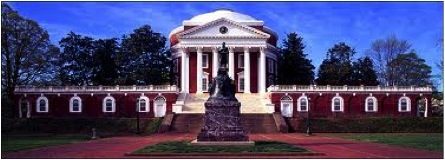
Would you explain the importance of timing in your work with the example of your image titled “Great Blue Heron on a Misty James River, Richmond, VA”?
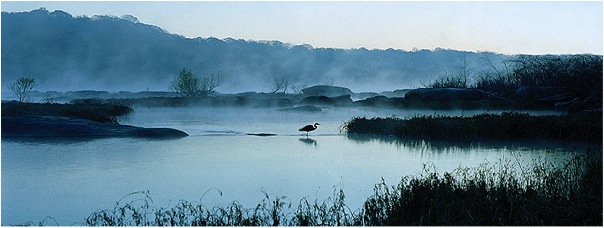
‘Great Blue Heron on a Misty James River, Richmond, VA’
One might not realize how critical it is that one is photographing at just the right time for a special image. A good example is what has become my favourite photograph and one that is on the cover of my book. This image features a beautiful misty portion of the James River that runs through Richmond, Virginia. The sun had not yet come up. In fact, when I arrived it was still so dark that I needed to use a flashlight to find a spot along the river where I wanted to set my camera and tripod. I set my camera up pointing toward the place where I expected the sun to eventually rise.
Before long it became light enough for me to see a great blue heron who was approximately fifty feet away and walking back and forth across a ledge in the river, apparently fishing for his breakfast. I had been to this spot other times but I had never seen a heron exhibiting that behaviour before. The conditions were perfect for a beautiful photograph except for one problem. The light was dim and I needed a faster shutter speed if I was going to be able to obtain a photograph of the heron where it would be recognizable and sharp. The heron’s movement would have ruined a photograph shot with a slow shutter speed.
Under those circumstances, fearing that the great blue heron would fly off, I decided to begin shooting with my film camera (this was approximately ten years before I converted to digital photography) and hope that I could time a photograph when the heron was moving only minimally. The film I was using was faster than the ones that I usually used, so the slightly higher shutter speed it permitted gave me hope. The only problem was that I only had one roll of that film which would give me twenty-one shots. I took those photographs and when I finished, unlike when one is shooting digitally, I did not know if my efforts would result in the photograph I sought. I wouldn’t know until the next day after the film was processed that I succeeded in getting the special shot I sought in the very last frame of the roll.
As you also work in black and white photography, why and when do your use this approach rather than colour?
Early on in my photography career, I was primarily a black and white photographer. I loved taking photographs with black and white film and translating the colours of the natural scene into dramatic shades of black and white and grey. I exhibit and show primarily colour images these days and my book, Natural Virginia, only has colour panoramas of my home state’s natural environment; however, I have never lost my interest in black and white images. In fact, I plan to focus some serious time on my black and white work this year. Interestingly enough, now instead of shooting black and white film, I can photograph the scenery in colour with a digital camera and modify the images in software so that they can be converted to black and white. It is not a difficult process to do but I think it can be difficult to convert the colour photograph into a really strong black and white image. That can take some significant time, effort and experience.
In this way, I can have the same photographs in both colour and black and white, and I love how so many scenes can look wonderful both ways, sometimes for different reasons. When I was shooting with medium format film from 1982 to 2007, I frequently loaded colour slide film in one Pentax 67 and black and while film in another Pentax 67, and I would photograph some scenes with both. The black and white photographs allowed me to focus my attention on the light, composition and subject matter without being overly influenced by the natural colour. Things have changed so that I can now shoot in colour and be able to enjoy the image in black and white as well.
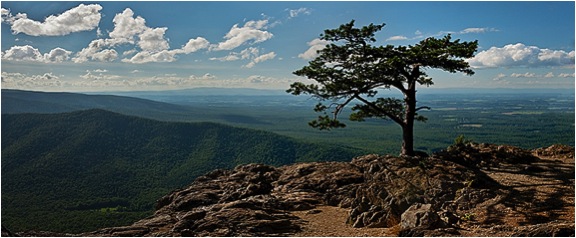
‘Ravens Roost in the Afternoon Light’
Can you show and discuss one of your photographs that you feel symbolizes Virginia, its long history dating back to 1607 and the state where eight Presidents have been born?
I believe Virginia and Ohio are the two states from which the largest number of Presidents have come, eight each. Virginia does have a remarkable history, one that features the very beginning of the permanent European settlements in North America. The foundation of our country literally began here.
The places that represent the history of the United States, places like Jamestown, Williamsburg, Richmond and the like, continue to attract photographers who seek to capture those aspects of the state. While I have experimented in such photography, it has not been a significant focus for my work. The primary exception to that statement is the University of Virginia, where I went to undergraduate and graduate school.
The University was founded by Thomas Jefferson, our third President and one who lived in the community in which I live. It is a highly respected public university, one of the best in the United States, but what still attracts me to the school is its remarkable architecture and the joy I have in photographing it. The Lawn, around which are the original buildings (for example, the Rotunda) and living quarters for professors and students are the best known visual elements of the University and ones that I never tire of photographing. I did maintain some self-control and only included one image of the University in Natural Virginia.
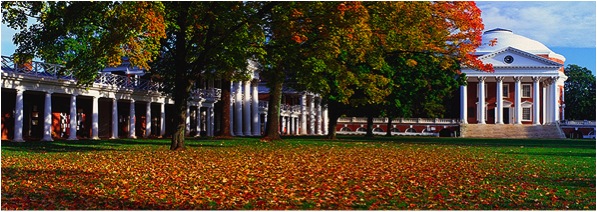
‘Fall Panorama on the Lawn, UVA’
Can you share with us how the photographs in your book, Natural Virginia, illustrate the four seasons in your home state?
Not only am I fortunate to live in a state that has remarkable diversity in its environment, I feel even more fortunate to live in one that features dramatically different seasons during the year. I love being able to photograph Spring, Summer, Fall and Winter, all in my own community and throughout the state. I have included four images below that represent the four seasons of the year found in Natural Virginia. Each one also represents the important qualities of my panoramic landscape photographs and the differences that are so visible at different times of the year.
“Little Stony Creek in Spring, Giles County, VA”
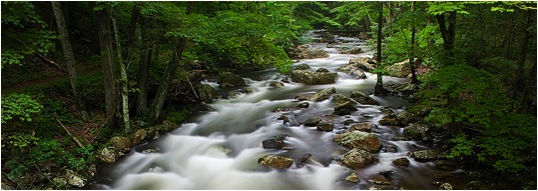
‘Little Stony Creek’
Discuss the image, its location, composition, the importance of timing and lighting and other important aspects of the photograph:
“Little Stony Creek in Spring, Giles County, VA” was photographed early one spring morning in southwest Virginia after a drive from home that was approximately three hours long. I knew if I could reach the trail that led to the creek not long after sunrise, the mountains on both sides of the creek would provide the perfect shady lighting conditions with no bright highlights created by the sun. In that light and with the need for a small aperture setting on the camera to give me maximum depth of field for sharp focus, I also knew that I would be able to shoot with a slow shutter speed creating a silky look to the flow of the water. I particularly liked being able to compose the photograph from a bridge crossing the creek, allowing the water to flow straight to the camera. The other important element of the photograph is the spring green colour of the leaves on the trees. I love to see the variations of that colour during that time of the year.
“Almost Sunrise on a Pond, Stanardsville, VA”
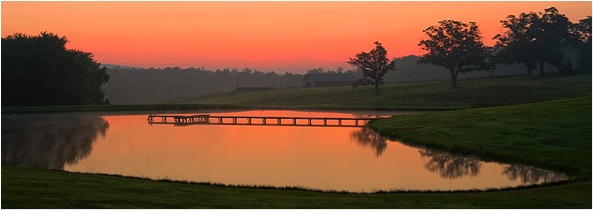
‘Almost Sunrise on a Pond, Stanardsville ’
Discuss the image, its location, composition, importance of timing and lighting and other important aspects of the photograph:
“Almost Sunrise on a Pond, Stanardsville, VA” was shot just before sunrise on a clear summer morning. I had discovered the pond on a recent drive when I was scouting for possible locations to photograph. I came across this pond when I was driving through the town of Stanardsville on the main road. I pulled over and determined that the pond had the potential for an outstanding photograph for several reasons. First, it was easily accessible for shooting just off the road. Second, the pond was high in elevation without trees or anything else that would prevent the sky from being reflected and visible in the pond. Third, I determined with my compass that the sun would rise each morning directly behind the pond. These things coupled with the beautiful setting of the pond with the dock and the trees that would be visible reflecting in the lake convinced me that there was great potential for a wonderful photograph. The pond was at least a half hour from my house, so I woke up early and drove there well before sunrise. I set up my camera and tripod and waited. Before long the sunrise began to light up the sky, creating colourful reflections in the pond. Composing the image in the camera was a simple matter given the elements around the pond. I love the serenity of the scene I captured.
“Early Fall Morning from the Blue Ridge Parkway, Nelson County, VA”
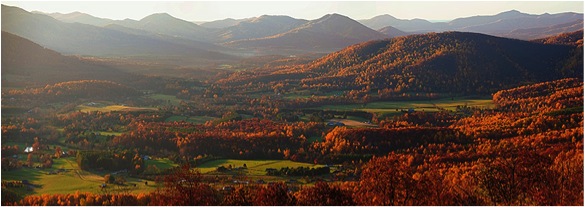
‘Early Fall Morning from the Blue Ridge Parkway’
Discuss the image, its location, composition, importance of timing and lighting and other important aspects of the photograph:
“Early Fall Morning from the Blue Ridge Parkway, Nelson County, VA” was shot from one of my favourite overlooks on the Virginia portion of the Blue Ridge Parkway. It was shot during the peak of fall colour in Rockfish Valley, which is surrounded by the Blue Ridge Mountains. Being there shortly after sunrise with the warm sunlight from the east permits one to capture an image with almost perfect side lighting that creates shadow patterns that add significant interest to the photograph. This lighting, which adds to the fall colour, gives a greater sense of depth and perspective to the photograph.
The composition is simple to achieve as I let the natural patterns of mountains that almost surround the valley create a perfect frame for the pattern of farms below. The fact that this location is within thirty minutes of my home makes it even easier to capture and enjoy the photograph.
“Snowstorm Panorama on Pantops Mountain, Albemarle County, VA”
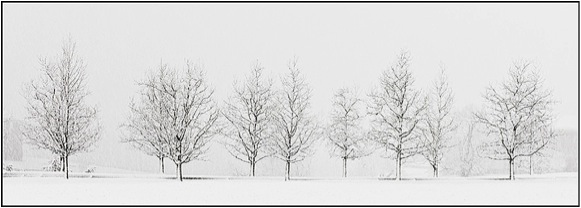
‘Snowstorm Panorama on Pantops Mountain’
Discuss the image, its location, composition, importance of timing and lighting and other important aspects of the photograph:
“Snowstorm Panorama on Pantops Mountain, Albemarle County, VA” was difficult to obtain due to the winter weather conditions that I was encountering. Early one afternoon in my hometown there began an intense snowstorm that was expected to last several hours at least. I immediately went to a nearby location with a natural environment that I hoped would provide me with some outstanding scenery to photograph. When I arrived I was delighted with the opportunities to photograph that lay before me. The snow was falling with such intensity that there was already the look of a winter wonderland. It was such a heavy snowfall that there was no colour in the area to be seen. The snow converted the entire scene to the look of a black and white pen and ink drawing.
I obtained several strong photographs that afternoon, this image is particularly pleasing to me. I went to a location that gave me a clear view of this line of trees that I had photographed previously in fog one fall morning. It was a relatively simple photograph to shoot once I got my camera and tripod set up properly in the correct location so that the composition was properly set. The intensity of the snowfall caused me to use an umbrella to protect the camera from the moisture. Making sure the line of trees was level in the photograph was particularly important. The exposure was also important because I wanted the snow to be white but not too bright. Because I wanted enough depth of field with a small aperture and the fact that the light was dim during the snowfall, my shutter speed had to be set slow enough for a correct exposure, thus helping to yield subtle streaks of snow throughout the image.
Discuss how important it is for you to help preserve Virginia’s scenic wonders?
I think my photographs can be enjoyed on many levels, but one of the most important is helping people understand not only how important it is to celebrate the natural environment but also its preservation. We live in an endangered world. We live at a time when we are beginning to wake up to the potential environmental dangers we face, but we have to wonder if it is too late to act and prevent those dangers from becoming a reality. I want people to recognize the importance of protecting our natural resources. I want people to recognize that they can make a difference in our efforts to do so.
I am very proud of the fact that nine state wide environmental organizations in Virginia, the organizations that are making a significant difference in our environmental protection efforts, have all expressed their support for Natural Virginia, and they have been kind enough to purchase copies and help inform their members and supporters about the book. They recognize the contribution the book is making to our environmental movement. In return I am also making my images available to the organizations for them to use in their marketing and public education efforts. I feel this is just one way that my photographs can help make a difference. This means a great deal to me.
I dedicated Natural Virginia to my two sons and five grandchildren. I did so expressing my hope that they and future generations will be able to fully experience and enjoy the environmental treasures that inspired me to create the book.
Would you discuss why your photographs reflect minimal human contact?
I like to say that I enjoy photographing Mother Nature at her finest. Minimizing the possibility of people being in my photographs would be consistent with that approach. If I am going to photograph the natural environment while minimizing the impact of humans on that environment, It seems to me that my photographs should limit to the extent possible people actually being in the photographs. In some cases I cannot avoid a person being in a photograph or an object that is manmade. In such cases, there may be a recognizable size that does add significant information to the viewer. This helps one understand the actual dimensions of that which is photographed. That isn’t always important, but there are landscapes I photograph in which that would be informative to the viewer. In one of my photographs, I have a truck on a spit of land going out into a lake. While I would prefer not having the truck in the photograph that was not possible at the time and its inclusion gives a real sense of scale to the photograph. I have a waterfall photograph that is not in my book that has two persons sitting on a large rock near the top of the waterfall. It is difficult to understand the height of the waterfall without their presence, but they are so small in the image that it is extremely difficult to even see them. So, while I want to minimize the presence of people so as to not interfere with the viewer’s appreciation of the image, I do understand that such presence can, under certain circumstances, add valuable information for the viewer.
“I have a love affair with the state of Virginia. I treasure its natural and remarkable diversity.” – Ben Greenberg.
Can you discuss the diversity of Virginia and how it is reflected in Natural Virginia?
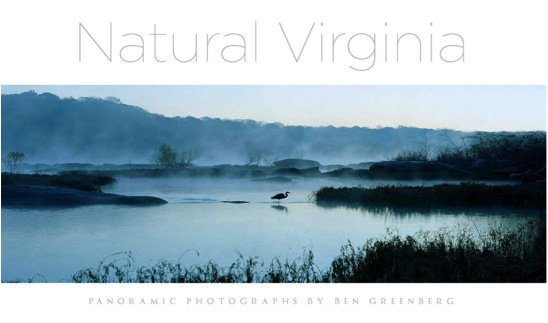
I want to say how fortunate I am to live in a state that has the diversity of natural environments worthy of photographing that Virginia has. We have the Eastern Shore that is not connected to any other part of the state with the Atlantic Ocean to the east and the Chesapeake Bay to the west. Further west is the mainland of Virginia. There is the Tidewater area with its many rivers that are tidal up to the fall line, then the large Piedmont area in the middle of the state (Piedmont meaning foothills), the range of the Blue Ridge Mountains immediately west of the Piedmont, the famous Shenandoah Valley west of the Blue Ridge, and the Alleghany Mountains at the border of Virginia and West Virginia. Each of these natural environments and their significant differences provide the photographer with almost totally different experiences in trying to capture memorable images, images that represent the essence of the state that I have always called home. This diversity gives the landscape photographer wonderful opportunities, in fact virtually unlimited opportunities to photograph. I feel very fortunate indeed to live in a state like Virginia. While there are other states on the east coast of the United States with some similar characteristics, I don’t think any other state has the full range of photogenic scenery found in Virginia and it is clearly reflected in the 122 photographs found in Natural Virginia.
Contact details.
Ben Greenberg
Email: ben@bengreenberg.com
Websites: www.bengreenberg.com
www.naturalvirginiabook.com
Ben Greenberg, Virginia, USA
Interview by Deborah Blakeley, June, 2014
Think a colleague or friend could benefit from this interview?
Knowledge is one of the biggest assets in any business. So why not forward this on to your friends and colleagues so they too can start taking advantage of the insightful information the artist has given?
Other artists you may be interested in:


